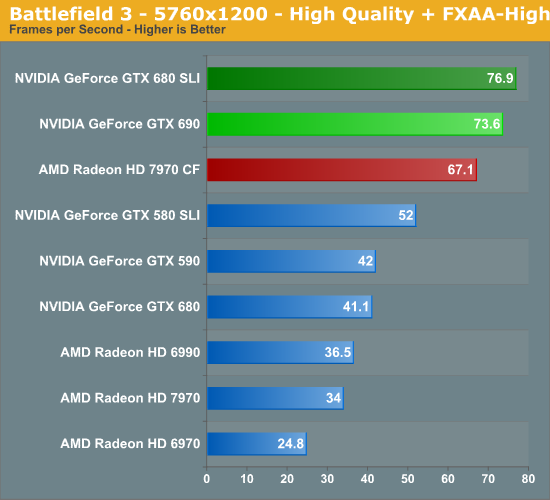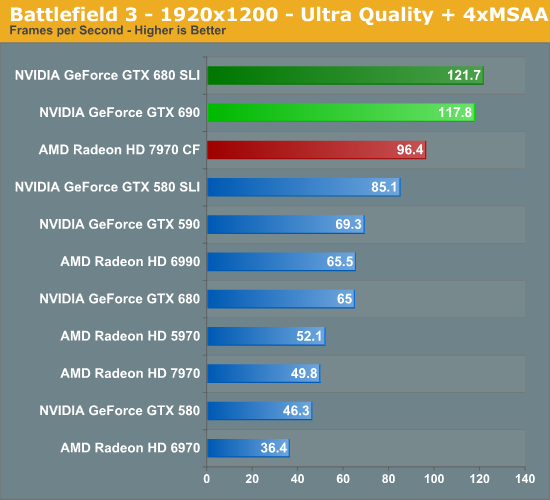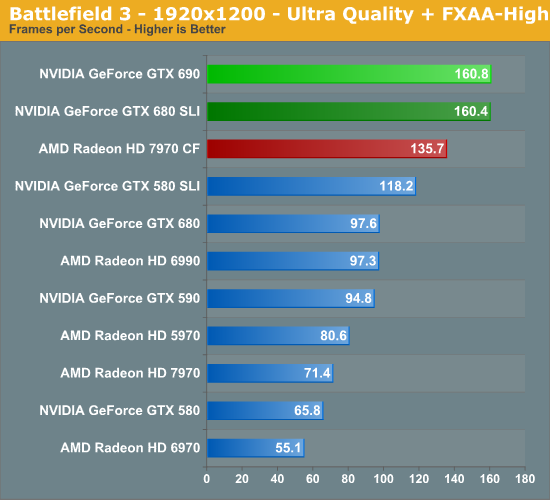NVIDIA GeForce GTX 690 Review: Ultra Expensive, Ultra Rare, Ultra Fast
by Ryan Smith on May 3, 2012 9:00 AM ESTBattlefield 3
Its popularity aside, Battlefield 3 may be the most interesting game in our benchmark suite for a single reason: it’s the first AAA DX10+ game. It’s been 5 years since the launch of the first DX10 GPUs, and 3 whole process node shrinks later we’re finally to the point where games are using DX10’s functionality as a baseline rather than an addition. Not surprisingly BF3 is one of the best looking games in our suite, but as with past Battlefield games that beauty comes with a high performance cost.




Battlefield 3 has been NVIDIA’s crown jewel; a widely played multiplayer game with a clear lead for NVIDIA hardware. And with multi-GPU thrown into the picture that doesn’t change, leading to the GTX 690 once again taking a very clear lead here over the 7970CF at all resolutions. With that said, we see something very interesting at 5760, with NVIDIA’s lead shrinking by quite a bit. What was a 21% lead at 2560 is only a 10% at 5760. So far we haven’t seen any strong evidence of NVIDIA being VRAM limited with only 2GB of VRAM and while this isn’t strong evidence that the situation has changed is does warrant consideration. If anything is going to be VRAM limited after all it’s BF3.
Meanwhile compared to the GTX 680 SLI the GTX 690 is doing okay here. It’s only achieving 93% of the GTX 680 SLI’s performance at 2560, but for some reason pulls ahead at 5760, covering that to 96% of the performance of the dual video card setup.










200 Comments
View All Comments
james.jwb - Thursday, May 3, 2012 - link
You are correct, I don't own one... I own three in triple screen. Dell U2412m's.I really am at a loss as to what you are on about. It is well known that 16:10 is preferred amongst enthusiasts and professionals for a few reasons. If you want 16:9, fine, go for it, but don't act like it's weird that AT are benching with 16:10 just because you went with cheap ass 16:9 screens.
CeriseCogburn - Friday, May 4, 2012 - link
Yes of course you are at a loss, you don't understand a word so why reply ?You're all at a loss.
ROFL
yelnatsch517 - Friday, May 4, 2012 - link
Are you being sarcastic or an idiot?From my experience 1900x1200 24" monitors are the MAJORITY. My work has roughly 50 24" monitors all in that resolution. My HP ZR24W is 1900x1200 as well. The only 24" monitor that I have even seen is the TN panel that came with an HP computer.
If you are talking about computer monitors, 1900x1200 is the dominant resolution. If you are talking about TVs, then obviously 1080p is the norm.
CeriseCogburn - Saturday, May 5, 2012 - link
There are 242 - count them, well over 200, nearly 250 1920X1080 monitors at the egg._
In your great experience, there are 16 that fit your 1920X1200 dreampipe FUD scenario at the egg, with most of them, well over half, over $400 each, while the 242 common monitors you all buy as you pinch every penny and whine about $10 difference in videocard prices are well under $200 each a lot of the time.
So now suddenly, you all spend way over $300 to plus $400 for 11% more pixels... ROFL HAHAHHAHHA instead of $150 or $200...
I guess that's why this place is so biased, the little bloggers are just as whacked when it comes to being honest.
InsaneScientist - Saturday, May 5, 2012 - link
Good grief... resorting to personal attacks isn't exactly a good way to get people to listen to you.I'm not going to argue that 1080p isn't more common (from what I've read, no one is), because it is more common, you are quite correct there, however I must point out that your logic to arrive at that conclusion is faulty:
You're contending that 1080p is more common (it is) because there are more models available on Newegg, but just knowing how many models are available doesn't tell us how many units those move.
If, for example, each of those 22 models of 1920x1200 monitors moves 10 times as much stock as each of the 1920x1080, nearly as many of the 1920x1200 will have been sold as the 1920x1080 ones.
Now, I don't think that's likely, and I do agree with you that 1080p is more common nowadays (see next point), but your argument is invalid, even though you have come to the correct conclusion.
Consider this: there are currently two models of iPhone available, compared to dozens of Android phones. By the same logic as you're using, I could say that the iPhone is incredibly rare - I'd get laughed out of town if I tried to make that argument.
The second point is that 1920x1200 hasn't been nearly as rare in the past as it is today. When I bought my previous monitor and my laptop (both 1920x1200), 1080p monitors were almost unheard of. Since monitors tend to last a while, it's not at all unreasonable for a disproportionate amount of people to be using them compared to their current sales.
Thirdly, there is a point of diminishing returns. Notice the complete lack of any benchmarks at or below 1680x1050? These cards are so fast that comparisons at those resolutions are pointless - they're all fast enough for anything you could do to them at that screen res - even Crysis. 1920x1080 almost falls into that category, heck, even 1920x1200 almost falls into that category. Benchmarks are only about who wins if there is some advantage to winning. Below 2560x1600, which card you're using is almost completely irrelevant, so why does it even matter whether they used 1920x1080 or 1920x1200?
CeriseCogburn - Tuesday, May 8, 2012 - link
Blah blah blah blah and I'm still 100% correct and you are not at all.Decembermouse - Tuesday, May 8, 2012 - link
You're quite a character.anirudhs - Thursday, May 3, 2012 - link
I use 2 at work - HP ZR24W.piroroadkill - Sunday, May 6, 2012 - link
Hm, odd.Not only do I have 1920x1200 monitor on my desktop, I have TWO laptops with 1920x1200 screens. Using one right now.
Yes, they're rarer than 1080p screens, but this is a site for enthusiasts, therefore, it is more likely.
Ryan Smith - Thursday, May 3, 2012 - link
The truth is a bit more simple than that. 5760x1200 is because our choice in monitors for multi-monitor testing was based on my personal monitor, which is another PA246Q. NVIDIA's limited display flexibility (same res + same sync) meant that it was easiest to just pair the PA246Q with some more PA246Qs, Consequently it's easier to just test these monitors at their native resolution when we're using NVIDIA cards.